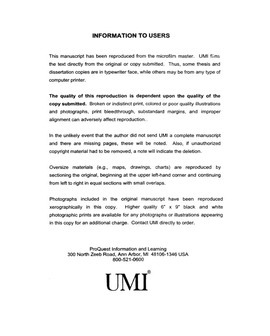| dc.contributor.advisor | Dunn, Loraine, | en_US |
| dc.contributor.author | Tabor, Susan Elaine. | en_US |
| dc.date.accessioned | 2013-08-16T12:18:22Z | |
| dc.date.available | 2013-08-16T12:18:22Z | |
| dc.date.issued | 2001 | en_US |
| dc.identifier.uri | https://hdl.handle.net/11244/355 | |
| dc.description.abstract | When centers varied by region, rural centers scored lower, however rural centers were not necessarily worse than urban centers. When centers varied by auspice, non-profits scored lower, however non-profit centers were not necessarily worse than for-profit centers. | en_US |
| dc.description.abstract | Dependent variables included structural aspects of child care environments, e.g., licensed capacity, enrollment, group size, teacher:child ratios, number of Master teachers and teacher and director education, experience, and income. Process quality dependent variables included environmental quality, developmentally appropriate practices, teacher beliefs about professional beliefs and practices, and director beliefs about leadership as well as teachers' beliefs about their director's leadership. | en_US |
| dc.description.abstract | Structural quality dependent variable analyses indicated accredited centers had larger group sizes, and more Master teachers than other Star levels. Two-Star centers had more Master teachers than One-Star centers. General education and specialized background in ece/cd of teacher and directors was higher when staff worked in accredited centers, rather than in One- or Two-Star centers. Teacher income from their jobs was higher for those working in accredited centers than those working in One- or Two-Star centers. | en_US |
| dc.description.abstract | The study compared 71 child care centers, matched by geographic region and auspice. It utilized a quasi-experimental design. Chi-square, univariate and multivariate analysis of variance were the primary statistical analyses conducted. Approximately 39% of the centers were rural, and 61% were urban. By auspice, there were no significant differences in the distribution of One-, Two-Star or accredited centers in either rural or urban settings. By region, there were significant differences in the distribution of One-, Two-Star or accredited centers in either nonprofit or for-profit settings. Accredited centers in both urban and rural areas were more likely to be non-profit than for-profit. In both rural and urban areas, One- and Two-Star centers were more likely to be for-profit. | en_US |
| dc.description.abstract | Teacher/director specialized education in ece/cd, teacher/director child care income, group size and the number of Master teachers correlated with quality and the presence of developmentally appropriate practices. Director child care income correlated with director leadership. | en_US |
| dc.description.abstract | Process quality dependent variables analyses indicated accredited programs scored higher on classroom environmental quality, developmentally appropriate practices, and teacher beliefs and practices regarding professionalism. | en_US |
| dc.format.extent | xiv, 217 leaves : | en_US |
| dc.subject | Education, Early Childhood. | en_US |
| dc.subject | Day care centers Oklahoma. | en_US |
| dc.title | A comparison of one-star, two-star, and accredited child care programs in Oklahoma. | en_US |
| dc.type | Thesis | en_US |
| dc.thesis.degree | Ph.D. | en_US |
| dc.thesis.degreeDiscipline | Department of Instructional Leadership and Academic Curriculum | en_US |
| dc.note | Chair: Loraine Dunn. | en_US |
| dc.note | Source: Dissertation Abstracts International, Volume: 62-06, Section: A, page: 2023. | en_US |
| ou.identifier | (UMI)AAI3018340 | en_US |
| ou.group | Jeannine Rainbolt College of Education::Department of Instructional Leadership and Academic Curriculum | |
